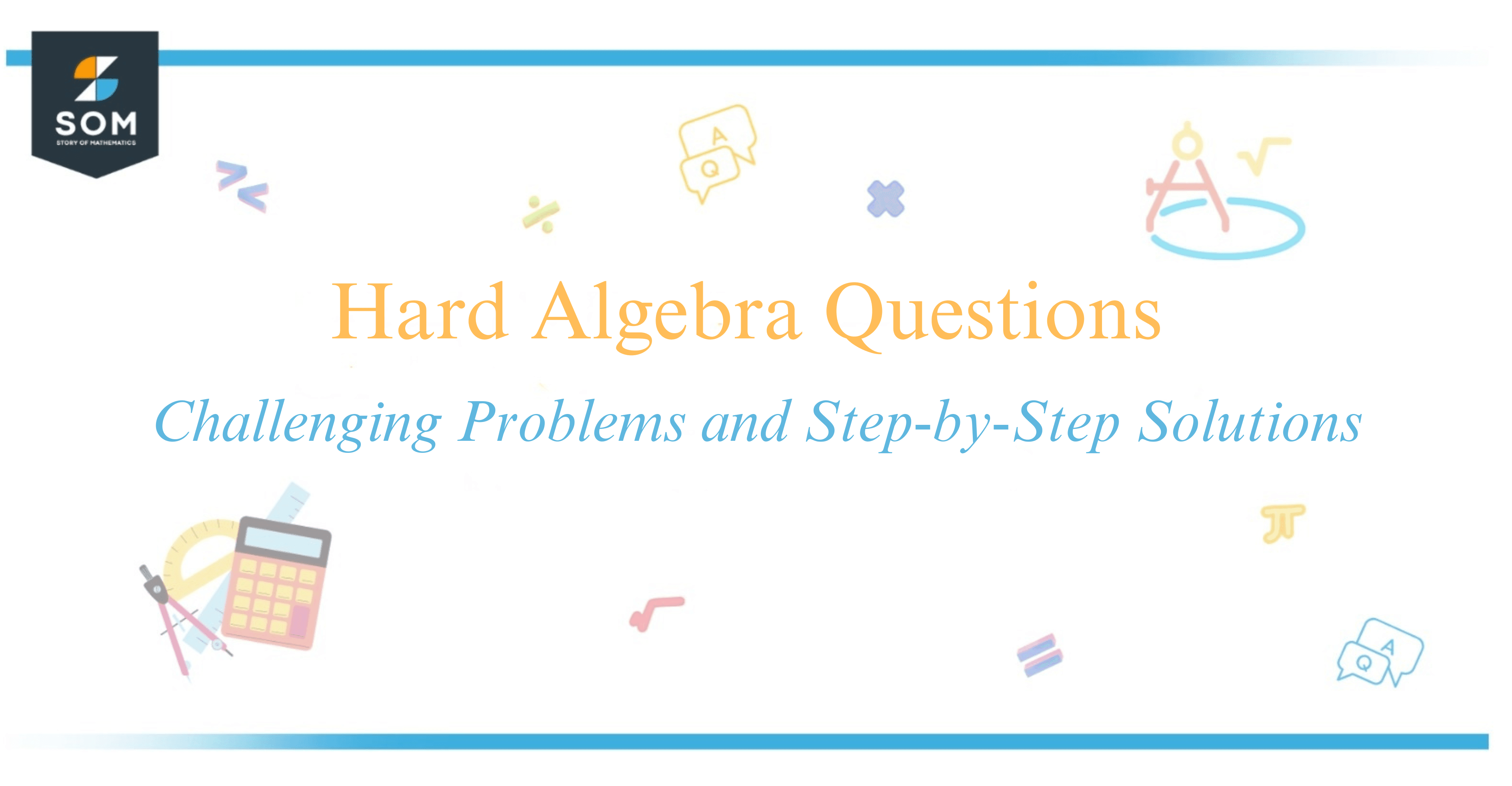JUMP TO TOPIC

Algebra is a fundamental branch of mathematics that deals with symbols and the rules for manipulating these symbols. In its most basic form, it is about finding the unknowns or the variables within equations.
As a student progresses, the questions in algebra can evolve from simple linear equations to more complex problems involving multiple steps, functions, or advanced concepts. Advanced algebra questions often probe one’s understanding of concepts like polynomial functions, rational expressions, exponents, and logarithms.
Navigating the web for reliable and challenging algebra problems and solutions I’ve found to be quite a task, but essential for anyone looking to master the subject. Websites and apps aimed at providing mathematics resources offer a range of problems, from basic to complex, helping learners tackle various topics effectively.
Engaging with these platforms allows for practice and reinforcement of algebraic concepts, which is crucial for solidifying one’s understanding and proficiency in mathematics.
I have to admit, that algebra can sometimes seem like a puzzle with a missing piece. But it’s that moment of clarity when the pieces fall into place that makes solving algebra questions incredibly rewarding. Stick around as we explore some hard algebra questions along with their solutions – the satisfaction of cracking them is just around the corner.
Understanding the Fundamentals of Algebra
Algebra can seem challenging, but by grasping some key concepts, I can work through even the tough problems.

The backbone of algebra is the equation, which is a statement that two expressions are equal, often containing an unknown quantity, usually represented by a letter like ( x ) or ( y ).
For instance, in the equation ( x + 3 = 7 ), my goal is to find the value of ( x ) that makes this statement true. To do this, I simplify the equation to find ( x ). Simplification might involve combining like terms or using inverse operations. So, in this case, I subtract 3 from both sides to isolate ( x ), yielding ( x = 4 ).
Inequalities are like equations, but instead of equality, they express a relation where one value is larger or smaller than another. This can be represented by symbols such as “>,” “<,” “≤,” or “≥.” For example, if I have ( x – 5 > 10 ), I’m looking for all values of ( x ) that make this inequality true.
Solving this, I add 5 to both sides to get ( x > 15 ).
Here’s a simple way to visualize the process of solving an inequality:
| Steps | Example |
|---|---|
| Write down the inequality | ( x – 5 > 10 ) |
| Perform the same operation on both sides | ( x – 5 + 5 > 10 + 5 ) |
| Simplify to find the solution | ( x > 15 ) |
Remember, if I multiply or divide both sides of an inequality by a negative number, the direction of the inequality sign flips. So, if I had ( -2x < 8 ), by dividing both sides by -2, it becomes ( x > -4 ).
Understanding the foundation allows me to simplify and solve equations and inequalities, providing the confidence to tackle more complex algebraic questions.
Solving Algebraic Operations
When I approach algebraic operations, I prioritize understanding the core concepts—exponents, factoring, complex numbers, and simplification.

These elements are the building blocks to solving more intricate algebra problems.
For exponents, remember that the base raised to the power of an exponent reflects how many times the base is multiplied by itself. For instance, $3^4$ means $3 \times 3 \times 3 \times 3$. When dealing with exponents, it’s essential to be familiar with the laws of exponents for simplification purposes.
| Law | Equation |
|---|---|
| Product of Powers | $a^m \cdot a^n = a^{m+n}$ |
| Quotient of Powers | $\frac{a^m}{a^n} = a^{m-n}$ |
| Power of a Power | $(a^m)^n = a^{m \cdot n}$ |
| Power of a Product | $(ab)^n = a^n \cdot b^n$ |
Next is factoring. I look for the greatest common factor (GCF) or use techniques like the difference of squares, and the quadratic formula for trinomials. For example, factoring $x^2 – 9$ would yield $(x + 3)(x – 3)$ because it is the difference of squares.
When it comes to complex numbers, which are in the form $a + bi$, where $i$ is the imaginary unit $(i^2 = -1)$, I remember that these numbers can be added, subtracted, and multiplied just like real numbers, with special attention to the property of $i$.
Finally, simplification is a matter of combining like terms and using the distributive property where necessary. For instance, to simplify the expression $2(x + 3) + x$, I first distribute the $2$ to get $2x + 6 + x$ and combine like terms to get $3x + 6$.
By mastering these components, I set a strong foundation for tackling hard algebra questions effectively.
Solving Advanced Algebraic Equations
Advanced algebra often serves as the foundation for calculus, statistics, and even programming. Let’s take a look at some of the core types of equations and how to approach them, including linear, quadratic, and systems of equations.
Linear Equations and Their Graphs
I’ll start by discussing linear equations, characterized by their straight-line graphs. A basic form of a linear equation is the slope-intercept form, expressed as ( y = mx + b ), where ( m ) is the slope and ( b ) is the y-intercept. Converting to standard form, ( Ax + By = C ), may be necessary for some applications. To graph these equations, I find two points by plugging in values for ( x ) and then plotting those points. Connecting these will give me a straight line.
Solving Quadratic Equations
Moving on to quadratic equations, these are typically presented in the general form ( a$x^2$ + bx + c = 0 ). These equations form parabolas when graphed.
I can solve quadratic equations using methods such as factoring, completing the square, or using the quadratic formula, ( x = $\frac{-b \pm \sqrt{b^2 – 4ac}}{2a}$ ). Each method has its own use cases; for example, factoring is efficient when the equation easily decomposes into binomials.
Systems of Equations
Lastly, I’ll tackle systems of equations, where I have to find the solution set of two or more equations. When solving linear systems, I can use methods such as substitution, elimination, or graphing.
Substitution involves solving one equation for a variable and then substituting that expression into the other equation, while elimination adds or subtracts equations to eliminate a variable. Graphing requires drawing lines of each equation to find their point of intersection.
| Method | When to Use It |
|---|---|
| Substitution | One variable is easily isolated |
| Elimination | Equations can be easily summed or subtracted to cancel out a variable |
| Graphing | Ideal for visual learners and small systems |
These are standard approaches that I often use to find the solutions to various types of algebraic equations.
Applications of Algebra
Algebra has countless applications in the real world, and one of the most practical applications is in calculating areas and perimeters of geometric shapes. Let me guide you through some examples:
Area of a Rectangle: To find the area of a rectangle, I use the formula:
$$ A = l \times w $$
where ( A ) represents the area, ( l ) is the length, and ( w ) is the width.
Perimeter of a Rectangle: Similarly, finding the perimeter is just as straightforward with the equation:
$$ P = 2(l + w) $$
where ( P ) stands for the perimeter.
Area of a Circle: When I look at circles, the area is found using:
$$ A = \pi r^2 $$
Here, ( A ) is the area and ( r ) is the radius of the circle.
Circumference of a Circle: And for the circumference, which is the perimeter of a circle, the formula is:
$$ C = 2\pi r $$
where ( C ) is the circumference.
| Shape | Formula for Area | Formula for Perimeter/Circumference |
|---|---|---|
| Rectangle | ( A = l \times w ) | ( P = 2(l + w) ) |
| Circle | ( A = $\pi r^2$ ) | ( C = 2$\pi$ r ) |
Understanding these formulas allows me to solve real-life problems, such as calculating the amount of paint needed to cover a wall or the fencing required for a circular garden.
With the help of algebra, I can create equations from word problems and solve them; the results help me make informed decisions and solve practical problems efficiently.
Conclusion
In our exploration of challenging algebra questions, I’ve presented a range of problems that test our understanding and application of algebraic concepts. From the intricacies of trigonometric equations to the puzzles of algebraic word problems, the journey through these issues illuminates the beauty of mathematics.
I sincerely hope that the solutions and strategies discussed have helped shed light on the complexity and elegance of algebra. Remember, practicing these tough problems not only sharpens your skills but also prepares you for more advanced mathematical challenges.
Whether you’re preparing for exams or simply indulging in the joy of problem-solving, the resilience and adaptability gained here are invaluable.
Algebra does not always yield its secrets easily, but patience and persistence in working through these tough problems can be immensely rewarding. Keep this momentum going, continue nurturing your mathematical curiosity, and let your confidence grow with each equation you solve.
